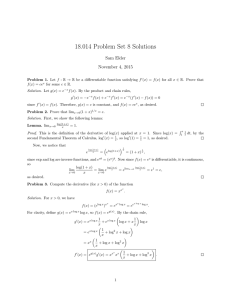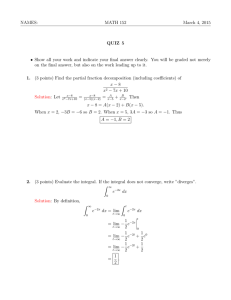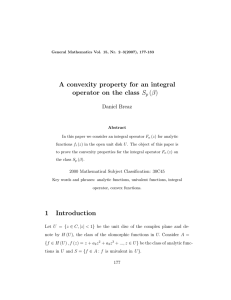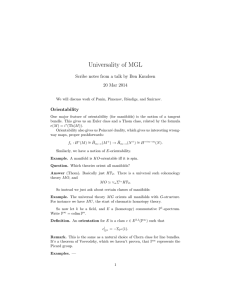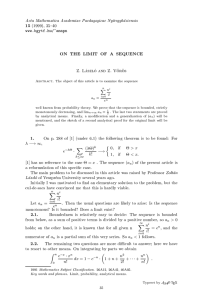Electronic Journal of Differential Equations, Vol. 2005(2005), No. 98, pp.... ISSN: 1072-6691. URL: or
advertisement
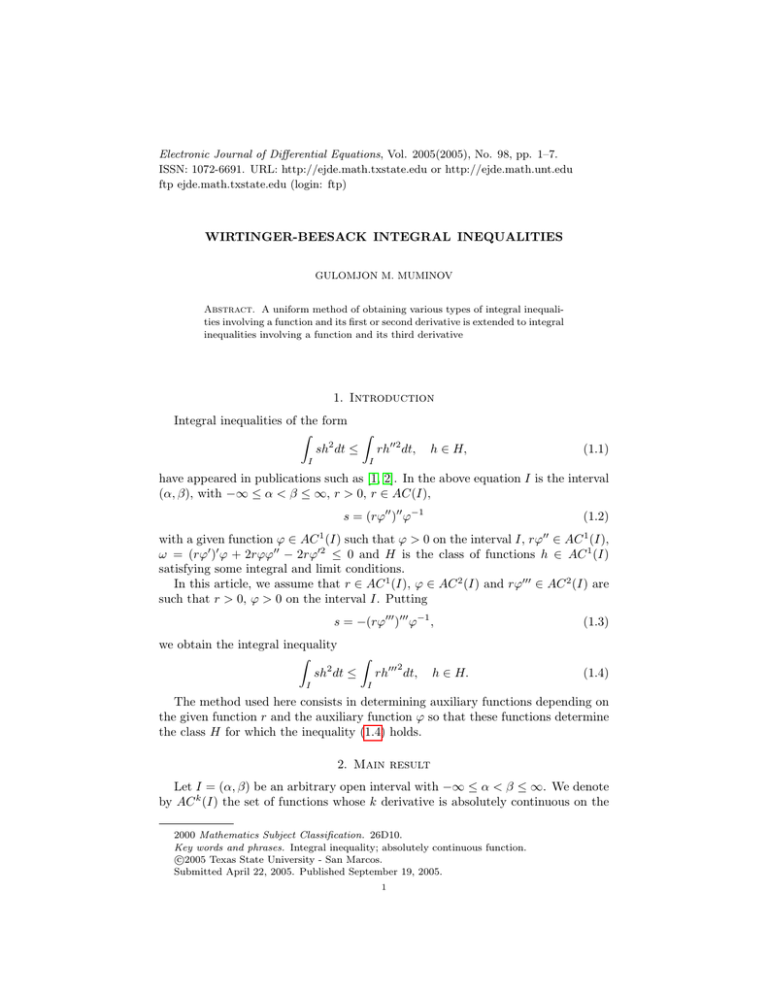
Electronic Journal of Differential Equations, Vol. 2005(2005), No. 98, pp. 1–7. ISSN: 1072-6691. URL: http://ejde.math.txstate.edu or http://ejde.math.unt.edu ftp ejde.math.txstate.edu (login: ftp) WIRTINGER-BEESACK INTEGRAL INEQUALITIES GULOMJON M. MUMINOV Abstract. A uniform method of obtaining various types of integral inequalities involving a function and its first or second derivative is extended to integral inequalities involving a function and its third derivative 1. Introduction Integral inequalities of the form Z Z 2 sh dt ≤ rh002 dt, I h ∈ H, (1.1) I have appeared in publications such as [1, 2]. In the above equation I is the interval (α, β), with −∞ ≤ α < β ≤ ∞, r > 0, r ∈ AC(I), s = (rϕ00 )00 ϕ−1 (1.2) with a given function ϕ ∈ AC 1 (I) such that ϕ > 0 on the interval I, rϕ00 ∈ AC 1 (I), ω = (rϕ0 )0 ϕ + 2rϕϕ00 − 2rϕ02 ≤ 0 and H is the class of functions h ∈ AC 1 (I) satisfying some integral and limit conditions. In this article, we assume that r ∈ AC 1 (I), ϕ ∈ AC 2 (I) and rϕ000 ∈ AC 2 (I) are such that r > 0, ϕ > 0 on the interval I. Putting s = −(rϕ000 )000 ϕ−1 , we obtain the integral inequality Z Z 2 sh2 dt ≤ rh000 dt, I h ∈ H. (1.3) (1.4) I The method used here consists in determining auxiliary functions depending on the given function r and the auxiliary function ϕ so that these functions determine the class H for which the inequality (1.4) holds. 2. Main result Let I = (α, β) be an arbitrary open interval with −∞ ≤ α < β ≤ ∞. We denote by AC k (I) the set of functions whose k derivative is absolutely continuous on the 2000 Mathematics Subject Classification. 26D10. Key words and phrases. Integral inequality; absolutely continuous function. c 2005 Texas State University - San Marcos. Submitted April 22, 2005. Published September 19, 2005. 1 2 GULOMJON M. MUMINOV EJDE-2005/98 interval I. Let r ∈ AC 1 (I) and ϕ ∈ AC 2 (I) be given functions such that r > 0, ϕ > 0 on the interval I and rϕ000 ∈ AC 2 (I). Let us put s = −(rϕ000 )000 ϕ−1 , Let us denote by H the set of functions h ∈ AC 2 (I) for which Z Z 2 rh000 dt < ∞, sh2 dt > −∞ I (2.1) I and satisfy the limit conditions lim inf S(t, h, h0 , h00 ) < ∞, t→α lim sup S(t, h, h0 , h00 ) > −∞, t→β lim inf S(t, h, h0 , h00 ) ≤ lim sup S(t, h, h0 , h00 ), t→α (2.2) (2.3) t→β where S(t, h, h0 , h00 ) 2 2 = ν0 (t)h2 + ν1 (t)h0 + ν2 (t)h00 + 2ε01 (t)hh0 + 2ε02 (t)hh00 + 2ε12 h0 h00 , (2.4) 1 rϕ00 0 3 − 2rϕ0 ϕ−2 (ϕ0 ϕ−2 )0 , ν0 (t) = [(rϕ000 )0 ϕ]0 ϕ−2 − rϕ000 ϕ−3 (ϕ2 )00 − 3(ϕ0 ϕ−1 )3 2 ϕ0 (2.5) ν1 (t) = −6(rϕ00 ϕ−1 )0 − 2r(ϕ00 ϕ−1 )0 + 4r(ϕ0 ϕ−1 )3 , 0 ν2 (t) = rϕ ϕ 000 0 ε01 (t) = −(rϕ ϕ) ϕ −2 00 + 3(rϕ ϕ −2 0 −1 , (2.7) 0 00 ) ϕ + r[(ϕ ϕ −1 2 ε12 (t) = rϕ(ϕ ϕ 0 ) − 4(ϕ ϕ ε02 (t) = r[(ϕ0 ϕ−1 )00 + ϕ0 ϕ00 ϕ−2 ], 0 (2.6) −2 0 ). −1 4 ) ], (2.8) (2.9) (2.10) These assumptions apply that ν0 ∈ AC(I), ν1 , ε01 ∈ AC 1 (I) and ν2 , ε02 , ε12 ∈ AC 2 (I). The following theorem is the main result of this paper. Theorem 2.1. Let 2 ω0 (t) = [(rϕ000 + (rϕ00 )0 ϕ−1 ]ϕ2 + rϕ00 ≥ 0, 02 ω1 (t) = 2rϕ − 2rϕ00 ϕ − (rϕ0 )0 ϕ ≥ 0 (2.11) (2.12) almost everywhere on the interval I. Then for every function h ∈ H the inequality (1.4) holds. If ω0 6= 0, ω1 6= 0 and h 6= 0 then (1.4) becomes an equality if and only if h = cϕ with c a non-zero constant, ϕ ∈ H, and and lim S(t, h, h0 , h00 ) = lim S(t, h, h0 , h00 ) . t→α t→β (2.13) Proof. For this proof, we use a standard method for obtaining various types of integral inequalities involving a function and its third derivative. See, for example, [1, 2] and the references cited there in. Let h ∈ AC 2 (I). From (2.4)–(2.10) and the assumptions, we have ϕ−1 h ∈ AC 2 (I) and S(t, h, h0 , h00 ) ∈ AC(I). If we substitute h = ϕf , where f ∈ AC 2 (I), EJDE-2005/98 WIRTINGER-BEESACK INTEGRAL INEQUALITIES 3 2 in the expression rh000 , then, after simple calculations, we obtain 2 2 rh000 = r (ϕ000 f + 3ϕ00 f 0 + 3ϕ0 f 00 + ϕf 000 ) = rh000 [ϕ000 f 2 + 3ϕ00 (f 2 )0 + 3ϕ0 (f 2 )00 + ϕ(f 2 )000 ] + r(3ϕ00 f 0 + 3ϕ0 f 00 + ϕf 000 )2 2 − 6rϕ000 (ϕ0 f 0 + ϕf 0 f 00 ) 2 = rϕ000 (ϕf 2 )000 − 3(rϕ000 ϕf 0 )0 + 3[(rϕ000 )0 ϕ − rϕ000 ϕ0 ]f 0 2 + r 3ϕ00 f 0 + 3ϕ0 f 00 + ϕf 000 . 2 Then, using the obvious identity rϕ000 (ϕf 2 )000 + (rϕ000 )000 ϕf 2 = [rϕ000 (ϕf 2 )00 − (rϕ000 )0 (ϕf 2 )0 + (rϕ000 )00 ϕf 2 ]0 , and r 3ϕ00 f 0 + 3ϕ0 f 00 + ϕf 000 2 2 2 2 2 = 3[rϕ00 + (rϕ00 )00 ϕ − (rϕ00 )0 ϕ0 ]f 0 + 3[2rϕ0 − 2rϕ00 ϕ − (rϕ0 )0 ϕ]f 00 + rϕ2 f 000 2 2 2 2 + 3[2rϕ00 ϕ0 f 0 + rϕ0 ϕf 00 + 2rϕ00 ϕf 0 f 00 − (rϕ00 )0 ϕf 0 ]0 , we obtain 2 2 2 2 rh000 = sh2 + 3ω0 f 0 + 3ω1 f 00 + rϕ2 f 000 n + [rϕ000 (ϕf 2 )00 − (rϕ000 )0 · (ϕf 2 )0 + (rϕ000 )00 ϕf 2 ] 2 + 3[2rϕ00 ϕ0 − (rϕ00 )0 ϕ − rϕ000 ϕ]f 0 + 6rϕ00 ϕf 0 f 00 + 3rϕ0 ϕf 00 2 o0 . Now substituting f = ϕ−1 h on the right hand side of the above identity, and using ϕf 2 = ϕ−1 h2 , (ϕf 2 )0 = (ϕ−1 )0 h2 + 2ϕ−1 hh0 , 2 (ϕf 2 )00 = (ϕ−1 )00 h2 + 4(ϕ−1 )0 hh0 + 2ϕ−1 h0 + 2ϕ−1 hh00 , f 0 = (ϕ−1 )0 h + ϕ−1 h0 , f 00 = (ϕ−1 )00 h + 2(ϕ−1 )0 h0 + ϕ−1 h00 , we obtain the identity 2 0 2 2 2 rh000 −sh2 = [S(t, h, h0 , h00 )] +3ω0 (ϕ−1 h)0 +3ω1 (ϕ−1 h)00 +rϕ2 (ϕ−1 h)000 . (2.14) 2 Now let h ∈ H. Condition (1.3) implies that the function rh000 is summable on 2 I since rh000 ≥ 0 on I. It follows from assumptions that the function sh2 and [S(t, h, h0 , h00 )]0 are summable on each compact interval [a, b] ⊂ I. Thus by (2.14) we get the summability of the function 2 2 3ω0 (ϕ−1 h)0 + 3ω1 (ϕ−1 h)00 + rϕ2 (ϕ−1 h)000 2 on each compact interval [a, b] ⊂ I and we obtain the equality Z b Z b b Z b 2 rh000 dt = sh2 dt + S(t, h, h0 , h00 ) + g(t)dt. a a a a for arbitrary α < an < bn < β, an → α, bn → β and lim S(t, h, h0 , h00 ) < ∞, lim S(t, h, h0 , h00 ) n→∞ an n→∞ > −∞. bn (2.15) (2.16) 4 GULOMJON M. MUMINOV EJDE-2005/98 Thus, there is a constant C such that bn −S(t, h, h0 , h00 ) ≤ C < ∞. an By condition (2.15), g ≥ 0 a.e. on I. From (2.16), we infer that Z bn Z Z bn 2 2 sh2 dt ≤ rh000 t + C ≤ rh000 dt + C, an an In and from this, letting n → ∞, we obtain Z Z 2 2 sh dt ≤ rh000 dt + C < ∞. I I From this estimate and by the second condition of (2.1), we conclude that sh2 is summable on I. Next, in a similar way, using (2.16) and the sum ability of the function sh2 on I, we prove that the function g is sum able on I. Thus all the integrals in (2.16) have finite limits as a → α or b → β, and hence both of the limits in (2.2) are proper and finite. Therefore the conditions (2.2) and (2.3) may be written in the equivalent form −∞ < lim S(t, h, h0 , h00 ) ≤ lim S(t, h, h0 , h00 ) < ∞. t→α t→β Now by (2.16) as a → α and b → β, we obtain the equality Z Z Z 2 rh000 dt − sh2 dt = lim S(t, h, h0 , h00 ) − lim S(t, h, h0 , h00 ) + gdt, I I t→β t→α (2.17) I hence, in view of (2.15), the inequality (1.4) follows, since g ≥ 0 a.e. on I. If (1.4) becomes an equality for a non-vanishing function h ∈ H, then by (2.15) and (2.17), we have Z gdt = 0, lim S(t, h, h0 , h00 ) = lim S(t, h, h0 , h00 ). (2.18) I t→α t→β Since g ≥ 0 a.e. on I, we obtain g = 0 a.e. on I. In view of g it follows from assumptions that it g = 0 a.e. on I, then (ϕ−1 h)0 (t0 ) = 0 for some t0 ∈ I, and we get that (ϕ−1 h)0 = 0 on I, since (ϕ−1 h)0 ∈ AC 2 (I). This implies that h = Cϕ, where C = const 6= 0, since ϕ−1 h ∈ AC 2 (I). Thus ϕ ∈ H, so that we obtain from the condition (2.18) we get the condition (17). Now let (2.17) be satisfied and let h = Cϕ, where C = const 6= 0. This implies R g = 0 a.e. on I, so that I gdt = 0. In view of (2.15)-(2.18), (1.4) becomes equality. The theorem is proved. 3. Example 2 a Let I = (−1, 1), r = (1 − t ) and ϕ = (1 − t2 )3−a on I, where a is an arbitrary constant such that the case a ∈ (−∞; 1] is considered. Then by (1.3), (2.11) and (2.12), we have s = −(rϕ000 )000 ϕ−1 = 24(3 − a)(2 − a)(5 − 2a)(1 − t2 )a−3 > 0, ω0 = 4 − (3 − a)(1 − t2 )2−a [(15 − 6a) + (12a − 30)t2 + (15 − 29a)t4 ] > 0, ω1 = 2(3 − a)(1 − t2 )5−a > 0 on I. EJDE-2005/98 WIRTINGER-BEESACK INTEGRAL INEQUALITIES 5 From Theorem 2.1. we obtain that the inequality (1.4) holds for every function h ∈ H, where H is the class of function h ∈ AC 2 ((−1, 1)) satisfying the integral condition Z 1 2 (1 − t2 )a h000 dt < ∞ (3.1) −1 and the limit condition −∞ < lim S(t, h, h0 , h00 ) ≤ lim S(t, h, h0 , h00 ) < ∞, t→−1 (3.2) t→1 where by (2.3)-(2.10) S(t, h, h0 , h00 ) = ν0 (t)(1 − t2 )a−5 h2 + ν1 (t)(1 − t2 )a−3 h0 2 2 + ν2 (t)(1 − t2 )a−1 h00 + 2ε01 (t)(1 − t2 )a−4 hh0 2 a−3 + 2ε02 (t)(1 − t ) 00 2 a−2 hh + 2ε12 (t)(1 − t ) (3.3) 00 hh , ν0 (t) =8(3 − a)t[−3(a2 − 3a + 1) + (12a3 − 90a2 + 238a − 222)]t2 + (−4a4 + 60a3 − 319a2 + 811a − 528)t4 ], ν1 (t) = −8(3 − a)t[6 − a + 2(7 − 2a)t2 ], ν2 (t) = −2(3 − a)t, ε01 (t) = 4(3 − a)[2a − 3 + (−10a2 + 52a − 66)t2 + (28a3 − 238a2 + 728a − 803)t4 ], ε02 (t) = −4(3 − a)[a + (2a2 − 11a + 16)t2 ], ε12 (t) = −4(3 − a)[1 + (7 − 2a)t2 ]. Since the second condition of (2.1) is satisfied trivially. Now we show that a function h ∈ AC 2 ((−1, 1)) that satisfies the integral condition (3.1) and limit conditions h(±1) = h0 (±1) = h00 (±1) = 0 belongs to the class H. At first we show that, if h(1) = h0 (1) = h”(1) = 0 and (3.1) hold, then lim S(t, h, h0 , h00 ) = 0 . t→1 Let us consider the right-hand neighborhood U of the point 1. In [1], it has been shown that 1−a (3.4) |h0 (t)| ≤ k(t)(1 − t) 2 for t ∈ U , where k(t) = A 1−a Z 1 2 (1 − τ 2 )a h00 (τ )dτ 1/2 > 0, t∈U. t This function is a continuous function on I, limt→1 k(t) ≡ k(1) = 0, and 3−a k(θ) |h(t)| ≤ √ (1 − t) 2 , 2−a (3.5) for t ∈ U , where t < θ < 1 and limt→1 k(t) ≡ k(1) = 0. It is easy to see that if we write h000 instead of h00 , h00 instead of h0 , and h0 instead of h in (3.4) and (3.5) then we obtain |h00 (t)| ≤ k(t)(1 − t) 1−a 2 (3.6) 6 GULOMJON M. MUMINOV EJDE-2005/98 for t ∈ U , with k as above and 3−a k(θ) |h0 (t)| ≤ √ (1 − t) 2 , 2−a (3.7) for t ∈ U , where t < θ < 1 and limt→1 k(t) ≡ k(1) = 0. From (3.5) we have |h(t)| ≤ 5−a 2k(θ) √ (1 − t) 2 . (5 − a) 2 − a (3.8) Based on the estimates (3.6), (3.7) and (3.8), from (3.3), we obtain |S(t, h, h0 , h00 )| ≤ k 2 (θ) 4k 2 (θ) |ν0 (t)| + |ν1 (t)| 2 (2 − a)(5 − a) 2−a 2k 2 (θ) + k 2 (θ)|ν2 (t)| + |ε01 (t)| (2 − a)(5 − a) 2k 2 (θ) k 2 (θ) √ + |ε02 (t)| + √ |ε12 (t)| = m(t) (5 − a) 2 − a 2−a Whence it follows that limt→1 S(t, h, h0 , h00 ) = 0. In an analogous way we show that if h(−1) = h0 (−1) = h00 (−1) = 0 and (3.1) hold then limt→−1 S(t, h, h0 , h00 ) = 0. Therefore we get the following result. Theorem 3.1. If a < 1 and the function h ∈ AC 2 ((−1, 1)) satisfies the integral condition Z 1 2 (1 − t2 )a h000 dt < ∞ −1 and the limit condition h(±1) = h0 (±1) = h00 (±1) = 0, then Z 1 Z 1 2 (1 − t2 )a h000 dt ≥ 24(3 − a)(2 − a)(5 − 2a) −1 −1 h2 dt . (1 − t2 )3−a holds. The inequality (3.4) becomes on equality if and only if h = C(1 − t2 )3−a , where C is a constant. In the particular case for a = 0 we obtain Z 1 Z 2 h000 dt ≥ 720 −1 1 −1 h2 dt (1 − t2 )3 as deduced in [3]. Acknowledgments. The author wishes to express his gratitude to the anonymous referee for his/her valuable remarks and comments on the original version of this paper. References [1] B. Florkiewicz and K. Wojteczek; On some further Wirtinger-Beesack integral inequalities, Demonstratio. Math. 32(1999), 495-502. [2] B. Florkiewicz and K. Wojteczek; Some second order integral inequalities of generalized Hardytype, Proc. Royal Soc. Edinburgh. 129 A. Part 5(1999), 947-958. [3] W. J. Kim; Disconjugacy and Nonoscillation Criteria for Linear Differential Equations. J. of Diff. Equation 8 (1970), 163-172. EJDE-2005/98 WIRTINGER-BEESACK INTEGRAL INEQUALITIES 7 Gulomjon M. Muminov Andijon State University, Faculty of Mathematics, 129, Universitetskaya str., Andijon, Uzbekistan E-mail address: muminov G@rambler.ru

